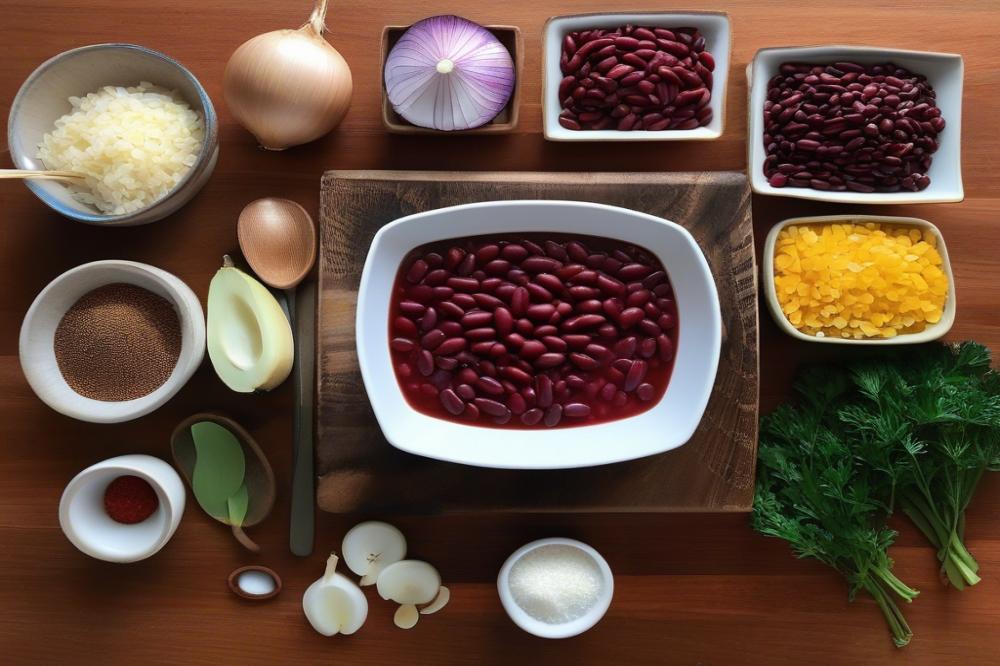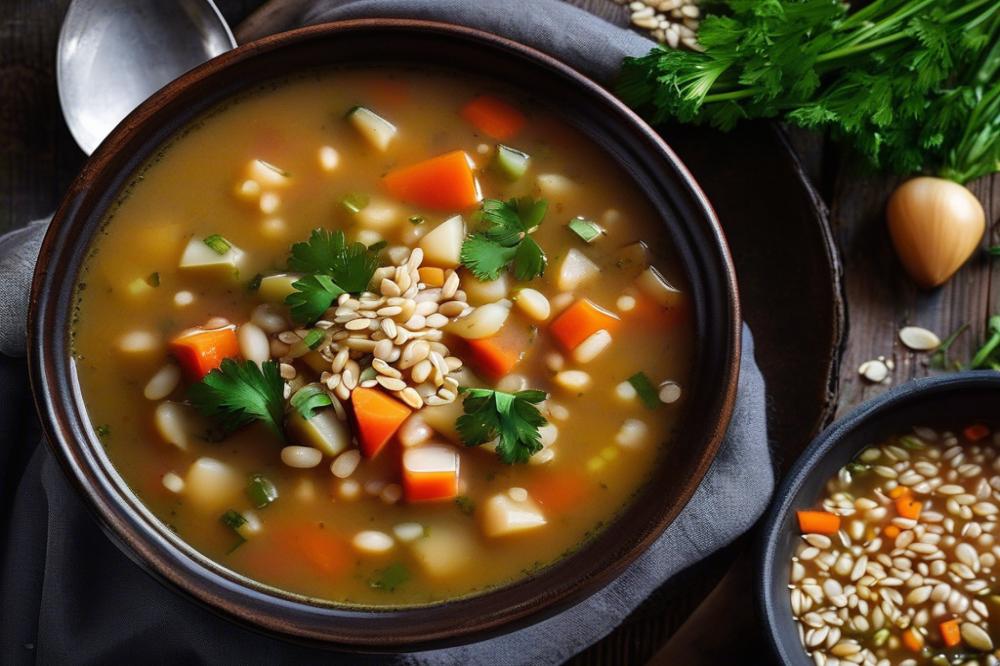Introduction
In Portuguese cuisine, Sopa de Feijão holds an esteemed place among hearty soup recipes. This flavorful dish showcases beans, which are a staple ingredient in many traditional dishes. Families often prepare Red Bean Soup to bring warmth and comfort, especially during colder months. Its rich depth of flavor and nutritious profile make it a sought-after meal.
Beans play a crucial role in Portuguese food. They are not only versatile but also packed with protein and fiber. Adding them to meals enhances both taste and health benefits. Cooking methods for beans vary widely, allowing for a range of textures and flavors. This encourages creativity in the kitchen, making it easy for anyone to create enjoyable dishes.
Beyond being delicious, Sopa de Feijão is considered a form of comfort food. Many enjoy it as a vegetarian soup option, perfect for those looking for healthy recipes. The ease of preparation contributes to its popularity among families. Whether served as a main course or a starter, Red Bean Soup remains a beloved choice for easy meals. Its significance in Portuguese culinary culture cannot be overstated.
Ingredients and Quantities

To prepare a hearty bowl of Sopa de Feijão, gather these ingredients:
- 2 cups red kidney beans (dry)
- 1 onion, chopped
- 2 cloves of garlic, minced
- 1 carrot, diced
- 1 potato, diced
- 4 cups vegetable broth
- 2 tablespoons olive oil
- 1 teaspoon smoked paprika
- Salt and pepper to taste
- Fresh parsley for garnish (optional)
Nutritional Information for Each Ingredient
When examining the ingredients, one can appreciate the health benefits they bring to the table. Red kidney beans are high in protein and fiber, making them a perfect base for vegetarian soups. Onions and garlic provide vitamins and have immune-boosting properties. Diced carrots contribute beta-carotene, which is good for eyesight, while the potato adds creamy texture and more nutrients.
Using vegetable broth enhances flavor and keeps the dish vegetarian. Olive oil is not just for sautéing; it’s a source of healthy fats. Smoked paprika can infuse the soup with depth and warmth, truly reflecting the essence of Portuguese cuisine. Finally, salt and pepper are essential for balancing flavors, while fresh parsley adds a pop of color and freshness to the finished product.
Benefits of Ingredients for Vegetarian Soup and Comfort Food
This dish showcases traditional dishes from Portuguese food that many people adore. Each ingredient serves dual purposes: creating delicious flavors and offering nutritional benefits. The beans allow for easy meals packed with protein, making them a staple in vegetarian recipes. Various cooking methods can be applied here, from soaking the beans overnight to speeding up the process with a pressure cooker.
The collective qualities of this red bean soup elevate it beyond mere sustenance. Comfort food often connects with emotional well-being, and this recipe encourages shared moments, warm gatherings, and cozy nights. It stands as a testament to how vegetarian soup can be both nourishing and satisfying, embodying the essence of healthy recipes that warm the heart.
Cooking Instructions

Step-by-step method for making Sopa de Feijão
Making this hearty dish starts with the preparation of the beans. First, select high-quality dried red beans. Rinse them well to remove dirt, stones, or impurities. After rinsing, soak the beans in water for at least four hours or overnight. Soaking softens the beans and reduces cooking time. It also helps to enhance their flavor.
Preparation of the beans (soaking and cooking)
Once soaked, drain and rinse the beans again. Now, place them in a saucepan with fresh water. The water should cover the beans by about two inches. Bring the water to a boil over medium heat. After boiling, reduce the heat and simmer until the beans become tender, which usually takes about 60-90 minutes.
Sautéing vegetables and combining flavors
While the beans are cooking, focus on the vegetables. Chop onions, carrots, and garlic finely. Heat olive oil in a skillet over medium heat. Add the chopped vegetables and sauté them until they become soft. Stir in some diced tomatoes for added flavor and color. Season with salt, pepper, and perhaps a pinch of smoked paprika for a warm touch. This step brings depth to the soup.
Simmering to achieve the right texture
After the beans have cooked through, combine them with the sautéed vegetables. Add vegetable broth or water to achieve the desired consistency. Bring everything to a gentle simmer. Allow the soup to cook together for about 30 minutes. This melding of flavors creates a rich, comforting dish that represents traditional Portuguese cuisine.
Tips for enhancing the flavor and consistency
To elevate the soup, consider adding a bay leaf during the simmering process. Such herbs contribute an aromatic quality. Boost the nutrition by incorporating leafy greens like kale or spinach, making this dish even healthier. If a creamier texture is desired, blend a portion of the soup and then return it to the pot. Adjust the seasoning as needed. Fresh parsley or cilantro sprinkled on top just before serving adds a burst of freshness.
This vegetarian soup serves well as comfort food and is perfect for easy meals any time of the week. Embrace the essence of Portuguese food while enjoying a delightful and nutritious bowl of soup that warms both body and soul.
Exploring Variations of Sopa de Feijão

Different regions in Portugal offer their own spins on bean soup. These dishes reflect local tastes and available ingredients. For instance, in the north, a rich and hearty version might include smoked meats. This variation enhances the soup’s flavor profile and adds depth. In contrast, the southern regions may favor lighter, more herbal notes, using fresh vegetables for a refreshing twist.
Additions of meat can transform the traditional bean soup into a fulfilling meal. Chorizo is a popular choice for providing spice and richness. Ham hock is another option, lending a savory element to the dish. Alternatively, for a vegetarian soup, mushrooms and kale work excellently, making it both nutritious and filling.
Spiciness is another variable to consider. Some cooks enjoy a kick in their recipes. A teaspoon of paprika or a pinch of cayenne can elevate the flavor. One might also add fresh chili peppers for a vibrant and fiery touch. Creaminess often comes from enriching the broth with cream or adding a puréed bean component. This method makes the dish velvety while keeping it wholesome.
Exploring different types of beans can also lead to exciting outcomes. Pinto beans are frequently used and offer a delightful texture. Black beans can give a unique flavor profile and appealing color. Adapting these ingredients in Portuguese food is a simple way to personalize easy meals, ensuring each variant has its charm. No matter the choice, beans are central to many traditional dishes in Portuguese cuisine and help define the essence of this comforting dish.
Some might even mix beans for added complexity. A combination of kidney beans and cannellini can provide interesting contrasts in both flavor and texture. These alterations make each bowl of soup a unique experience, inviting creativity in the kitchen. By understanding these variations, home cooks can embrace Portuguese soup recipes and the comforting qualities they bring.
Serving Suggestions

Best sides and accompaniments for Sopa de Feijão
Pairing food enhances the meal experience. In Portuguese cuisine, bread is often a staple. Serve a crusty loaf of pão, a traditional bread, for a hearty addition. Cornbread is another delicious option, adding a sweet contrast. A fresh salad can balance the richness of the soup. Consider mixing greens with tomatoes and onions drizzled in olive oil. These sides complement soup recipes beautifully, enhancing the overall flavor profile.
How to serve and present the soup
Presentation matters when serving food. Use deep bowls to showcase the soup’s rich color and texture. A sprinkle of chopped parsley or cilantro can add a pop of color on top. Instead of a single serving spoon, provide ladles for guests to serve themselves. This creates a homely atmosphere and encourages sharing. For a unique touch, consider serving with a side of pickled vegetables. They can provide a delightful tang and contrast to the warmth of your Portuguese food.
Ideas for garnishing and enhancing the serving experience
Garnishes can elevate any dish. For Sopa de Feijão, try crumbled feta or goat cheese for added creaminess. A drizzle of high-quality olive oil can enhance the soup’s flavors and add a touch of elegance. Offering a variety of spices at the table can allow guests to customize their bowls. Consider providing smoked paprika or fresh chili flakes for those who enjoy a kick. By creating an engaging dining experience, you turn a simple dish into comforting meals full of personality.
Wrapping Up the Journey into Sopa de Feijão
Sopa de Feijão is more than just a dish; it embodies the warmth and spirit of Portuguese cuisine. For generations, families have gathered around the table to share this comforting meal. This dish is a symbol of nourishment, love, and tradition in many households. Understanding its background helps us appreciate its impact on culture.
Trying to make this traditional soup at home can be a rewarding experience. Simple ingredients are transformed into a flavorful meal through careful preparation. Following the steps outlined in earlier sections can lead to a delightful dish that your family will surely enjoy. Cooking together can also strengthen bonds, making the experience even more special.
Beans are a key component of many healthy recipes. They provide not only rich flavors but also essential nutrients. Incorporating beans into your meals can lead to improved health benefits, such as better digestion and heart health. Embrace this ingredient by experimenting with it in other dishes, too. Each attempt in the kitchen can broaden your culinary skills while adding variety to your diet.
So go ahead! Dive into the world of homemade soup. Engage with the tradition, savor the tastes, and enjoy the process. Your effort will not only bring to life a cherished dish but will also enhance your journey through the rich landscape of flavors found in Portuguese cuisine.



